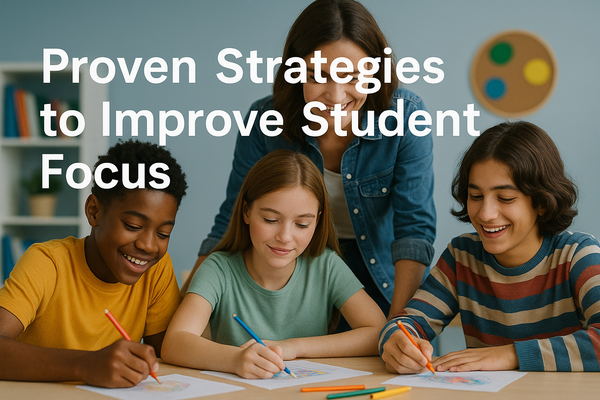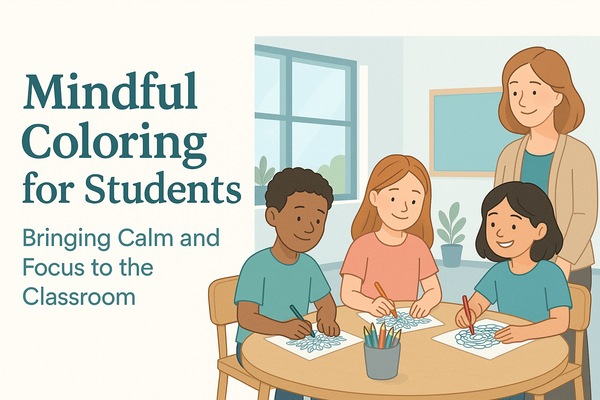Enhance Learning: The Top 7 Benefits of Flexible Classroom Seating

Imagine a classroom where your students have the freedom to choose the perfect spot of their choice to learn. Whether curling up on a bean bag or sitting at a traditional desk, flexible classroom seating is all about giving students control over their learning experience.
Flexible seating can boost student engagement and even improve academic progress. The way the classroom is set up plays a huge role in how students learn, making it clear that a thoughtful layout in the classroom is a tool for education. This blog will discuss the top 7 benefits of flexible seating and how it transforms the learning experience.
What is Flexible Seating?
Flexible seating is a modern approach to classroom design that allows students to choose from a variety of seating options tailored to their preferences and needs. Unlike the rigid desk structure, flexible seating allows students to opt for alternatives such as bean bags, standing desks, wobble stools, floor cushions, or even mats.
The setup is designed to create a more dynamic learning environment where students feel empowered and engaged. At its core, the philosophy behind flexible seating is around the idea that students learn in the way they feel most comfortable. It is not about rearranging furniture; it is about establishing a sense of ownership of the learning space.
Benefits of Flexible Seating Plans
Flexible seating is a transformative approach to cater to the diverse needs of students while creating a supportive learning environment. The following are the top 7 benefits of having flexible seating in the classroom.
Student Engagement
One of the standout benefits of flexible seating in the classroom is its ability to enhance student engagement. When students are given the freedom to choose where they want to sit, they are likely to feel invested in their learning environment. The sense of having control and freedom over your choices helps them stay focused.
Choice plays a significant role in increasing participation. A student who usually struggles to maintain their focus while sitting at the same desk, it gets easier for them to concentrate on a different seating, such as a wobble stool or a bean bag. Movement with a flexible seating arrangement also helps students channel their energy into class activities.
In classrooms with flexible seating, teachers also notice a significant difference in participation and discussions. Students are more likely to raise their hands and remain attentive during lessons because they are physically comfortable. It is always a great idea to let students choose the environment where they can thrive for increased engagement.
Collaboration and Communication
Flexible seating in the classroom gives students a chance to choose from dynamic space, which fosters collaboration and communication among students. By breaking away from the traditional setting, students can freely move around, and it promotes natural interactions while also building social skills.
For instance, when students are working on a group project, gathering on a low table with floor cushions or sitting on bean bags in a circle creates a more informal and approachable atmosphere. This setup removes barriers and allows ideas to move freely among the group members. Such flexible seating makes students rearrange themselves for group activities.
Real-life scenarios also demonstrate the benefits of flexible seating, as teachers often observe quieter students become more involved when the setting is a little informal. Students naturally shift between different seating areas during the day while also setting the foundation for stronger communication skills.
Creativity and Innovation
Allowing students to choose from flexible seating options can be a game-changer for fostering creativity and innovation. The freedom to choose where and how to sit makes students less concerned about their learning environment, eventually leading to them thinking outside the box. A relaxed environment can reduce stress and create the mental space needed for creativity.
For example, a student brainstorming for a writing assignment might want to sit on a bean bag near a window instead of sitting on a fixed desk. Other students might prefer standing desks, which keep their energy level high and help them think more dynamically. Classroom projects also often showcase the impact of flexible seating on creativity.
Whether students are designing a group presentation, crafting an art project, or coding a simple program, students in flexible-seating classrooms tend to approach tasks with enthusiasm. The physical freedom they experience mirrors their mental freedom, making flexible seating a driver to innovative thinking.
Diverse Learning Styles
Every student learns differently, and flexible seating options give an effective way to accommodate diverse learning styles. Students who thrive on movement may benefit from wobble stools or standing desks, allowing them to be physically active while also focusing on their lessons.
Visual learners will be more drawn towards the seating that is close to visual aids like whiteboards or projectors, while auditory learners might prefer quieter areas to focus on listening. By catering to individual preferences, flexible seating helps students perform at their best.
A student who is struggling with staying in a still chair might excel when given the option to sit on a yoga ball, which lets them bounce gently while also staying engaged in the lesson. This approach enhances their learning experience, reduces frustration, and increases confidence. The ability to be adaptive makes flexible seating an invaluable tool in modern classrooms.
Behavior and Discipline
Flexible seating options can lead to significant improvements in behavior and discipline. Traditional classrooms often restrict movement, leading to restlessness and disruptive behavior. However, in a classroom with flexible seating, students move and settle into spaces where they feel most comfortable.
Such seating arrangement also minimizes conflicts and distractions. When students are given the autonomy to select their seating, they feel more respected and exhibit greater respect for classroom rules. The increased comfort also makes them channel their energy constructively, resulting in fewer behavioral issues.
For example, in classrooms with flexible seating, teachers report disease in incidents of students talking out of turn or leaving seats without permission. Students become more focused, and they are less likely to act out when they are comfortable and engaged. Every student benefits from such an arrangement and overall productivity in the classroom increases.
Physical Health and Comfort
Sitting for long hours in traditional chairs can take a toll on students’ physical health. Flexible seating addresses this issue by encouraging movement throughout the day. Wobble stools, yoga balls, and standing desks provide opportunities for students to stretch and shift positions, promoting better posture and circulation.
Physical comfort is also tied to mental focus, as a student who feels at ease in their seat are more likely to stay attentive during lessons. By integrating movement in the classroom, prolonged sitting is removed from the class, and it improves the overall physical well-being of students.
Flexible seating becomes a win-win for both teachers and students, as students will get to choose the seating style according to their comfort. Students will choose the way they feel more comfortable while learning, helping both energetic students and students who want a cozy way to learn in the same classroom.
Responsibility
One of the prominent benefits of flexible seating in the classroom is empowering students to take responsibility for their own learning. By allowing them to choose their seats, teachers encourage students to make decisions based on what helps them focus and perform best. This freedom in decision-making teaches them valuable life skills, such as self-awareness and accountability.
Students should also be given a chance to adapt to different learning ways based on the type of learning they are engaged in. A student may start studying at their desk for maths lessons but move to a bean bag later for independent reading. Each choice will require them to evaluate their own needs and also figure out what is working best for them.
Teachers also use flexible seating as an opportunity to enhance accountability. If a student is not using their seating choice responsibly, they may be asked to reflect on their behavior and make better decisions. This approach also helps students understand the impact of choices and develop a sense of ownership of their actions.
Create a Variety of Seating Options
Flexible seating structure thrives by offering students diverse choices to suit their individual needs. By incorporating a mix of traditional and unconventional seating arrangements, classrooms can become more engaging and conducive to learning. Here are some creative and practical seating arrangements teachers can consider.
1. Pillows and Floor Seating
Throwing pillows on the floor creates a cozy and informal learning space where students can sit comfortably. This is an appealing option for younger students, who usually prefer sitting closer to the ground. Floor seating also promotes a relaxing environment during activities like reading and group discussions.
2. Bean Bags
Bean bags are a favorite in flexible classrooms due to the comfort and versatility they bring to the classroom. These soft, cushioned seats conform to the body, providing a relaxing option for activities like reading and brainstorming. Bean bags are a great option for students who want to have a more relaxed seating arrangement.
3. Crate Seating
Simple yet effective, crate seating involves repurposing plastic crates with added plywood and foam cushions. This DIY option is portable and perfect for classrooms with limited budgets. Crate seats can be used for small group activities or as additional seating around the room.
4. Wobble Stools
Wobble stools are a dynamic seating option designed for students who need to release pent-up energy while staying engaged. Wobble stools are lightweight and adjustable, making them suitable for a range of ages and tasks.
5. Standing Desks
Standing desks offer a healthy alternative to traditional sitting arrangements, promoting better posture and reducing the physical strain associated with prolonged sitting. They are also a great option for students who prefer to stay on their feet while learning.
7. Loft Spaces
For classrooms with space, lofts can add an exciting element. These provide unique seating areas for students who like a bird’s eye view of the classroom. Additionally, the space beneath can be used for storage.
8. Canoes and Themed Furniture
Unconventional items like canoes can double as seating spaces and creative props that spark the imagination. Students can sit inside the canoe for reading and brainstorming sessions, making learning feel like an adventure.
Steps to Implement a Flexible Seating Plan
Transitioning to a flexible seating classroom requires thoughtful planning to ensure a smooth and effective implementation. Here are key steps you can take:
Assess Your Classroom Needs
Before making any changes, evaluate the unique needs of your students and the classroom space. Consider factors such as class size, age group, and the types of activities students regularly engage in. This will help you decide what seating plan you want to go for.
Start Small
Implement a flexible seating plan gradually to avoid overwhelming students with the change. Begin by introducing a few new seating options, such as bean bags and wobble stools, and observe how students respond. This phased approach will allow teachers to gauge what is working best for students.
Set Clear Expectations
To maintain order and discipline, establish rules for using flexible seating. For instance, students should understand that seats are chosen for learning purposes, not as a means of socializing or distracting others. Having a seating rotation system can ensure fairness and accountability.
Involve Students in the Process
Engage students by allowing them to share input on what seating options they would find most comfortable. Their involvement will give them a sense of ownership but also ensure the seating plan meets their needs.
Test and Adjust
Once the new seating arrangements are in place, monitor the impact on student behavior and learning. Be open to feedback from students to make adjustments as needed. Flexibility is just as important as the seating itself.
Conclusion
Incorporating flexible seating in the classroom is more than a design change; it is a shift toward fostering engagement and creativity. By offering diverse seating options, teachers can create a dynamic learning environment that caters to different learning styles. While implementation requires thoughtful planning, the benefits in student behavior and overall productivity are undeniable.




